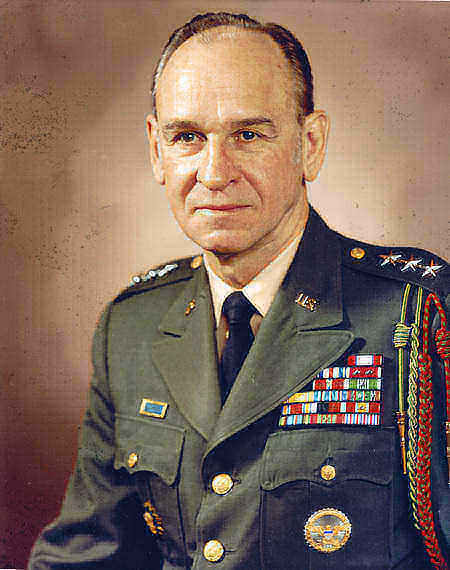George E. Pickett, Sr. was born in Palestine, Texas 26 May 1918. He graduated from the U.S. Military Academy, West Point, New York, with a Bachelor of Science degree in 1939. His military career began 12 June 1939 when he was commissioned as Second Lieutenant in the Signal Corps of the Regular Army. His first Assignment was at Fort Monmouth, New Jersey, and with the 1st Infantry Division throughout World War II, participating in eight campaigns, including D-Day landings in France, North Africa, and Sicily.
He returned to the U.S. in April 1946 and was assigned to the G-3 section of Headquarters Army Ground Forces which was then located in Washington, D.C. and was later moved to Ft. Monroe, Virginia.
In June 1949 General Pickett was transfered to the Office of the Chief signal Officer, Washington, D.C. where he served as Chief of the Signal Corps Career Management Branch and later as Assistant Chief of the Personnel and Training Division.
In February 1951 General Pickett was selected for attendance at the Armed Forces Staff College, Norfolk, Vorgomia, and upon graduation in 1951 was assigned to the Strategic Logistics Branch, Plans Office, Assistant Chief of Staff G-4, Department of the Army.
In October 1952 General Pickett was transfered to the Office of the Under secretary of the Army in the Pentagon where he remained until August 1956. During this period he served as Executive Officer for two years.
In August 1956 General Pickett was selected for attendance at the National War College and upon graduation in 1957 was assinged to the Military Assistance Advisory Group in Taiwan. During his service in Taiwan he held positions as Assistant Chief of Staff (J-5) on the Joint Staff of the U.S. Taiwan Defense Command/Military Assistance Advisory Group: Chief Signal Officer: MAAG and Signal Officer Army Section MAAG.
General Pickett returned from Taiwan in July 1959 and became Signal Offficer of the U.S. Army Ordinance Missile Command at Redstone Arsenal, Alabama.
In 1961 he was selected for and attended the Advanced management Course at Harvard University. Upon graduation from Harvard he returned to the Missile Command at Redstone Arsenal.
In 1962 General Pickett was transferred to the Eighth Army Headquarters in Korea where he served as the Army Signal Officer.
Returning to the United States in May 1963, General Pickett was assigned to the Office of Personnel Operations, Headquarters, Department of the Army, where he served successively as Chief, Combat Support Division and Director of Officer Personnel until March 1965.
In 1965 General Pickett was assigned to the Defense Communications Agency in Washington, where he remained until March 1968. During this period he served as Deputy Director, Defense Communnications Systems and from December 1967 to March 1968 as Vice Director of the Agency.
On 1 March 1968 General Pickett assumed the duties as the Assistant Chief of Staff for Communications-Electronics, Headquarters, Department of the Army.
On 10 April 1972 General pickett was promoted to Lieutenant General and effective 18 April 1972 was assigned to the Office of the assistant Secretary of Defense (telecommunicatios) as the Deputy Assistant Secretary of Defense (Management).
Through his military career General Pickett received the following citations, decorations and or service medals: Distinguished Service Medal, Silver Star, Legion of Merit with 2nd Oak Leaf Cluster, Bronze Star with V Device, Army Commendation with Oak Leaf Cluster, Croix de Guerre (France), War Cross (Czechoslavakia), Fourragere (France), Fourragere (Belguim), Presidential Unit Citation, Meritorious Unit Emblem, American Defense Service Medal, European, African, Middle Easter Campaign Medal (one Silver, three Bronze, one Arrowhead) American Campaign Medal, WWII Victory Medal Army Occupation Medal (Germany) National Defense Service Medal with Oak Leaf Cluster, Armed Forces Expeditonary Medal. He served in the following campaigns Algeria-French Morocco, Tunisia, Sicily, Narmandy, Northern France, Rhineland, Ardennes Alsace, Central Europe.
In May 1974 General Pickett retired from the Army to become the Executive Vice President and General manager of the Armed Forces Communications and Electronics Association.
In January 1977 General Pickett assumed the position of Executive Vice President of the United States Independent telephone Association retireing in 1984.
Although General Pickett retired he used his expertise and became very active in Alexandria Civic Affairs. He was a Board member of the Seminary Hill Association, Vice President and Board member of the Federation of Associations, Board member for the Citizens for Abatement of Aircraft Noise, a member of the Alexandria Hospital and Sercives Corporation.
General Pickett was maried to Jane Stanton of Rye, New York, in 1939 and had four children, George E. Pickett, Jr., Jane Gray Souders (deceased), Thomas D’Aubigne Pickett and Sharon Pickett Mills. General Pickett died on May 18, 2008 at the Walter Reed Army Medical Center and is survived by eight grandchildren and four great grandchildren.
The Family has requested that donation in his name be made to The American Heart Association.
General Pickett was laid to rest with full military honors on Thursday, 31 July 2008, at Arlington National Cemetery following services at the Post Chapel at Fort Myer, Virginia.
PICKETT, GEORGE EDWARD
LTG US ARMY
WORLD WAR II, KOREA
DATE OF BIRTH: 05/26/1918
DATE OF DEATH: 05/18/2008
BURIED AT: SECTION 60 SITE 6205
ARLINGTON NATIONAL CEMETERY
Michael Robert Patterson was born in Arlington and is the son of a former officer of the US Army. So it was no wonder that sooner or later his interests drew him to American history and especially to American military history. Many of his articles can be found on renowned portals like the New York Times, Washingtonpost or Wikipedia.
Reviewed by: Michael Howard

